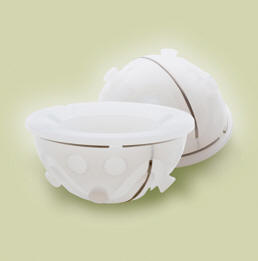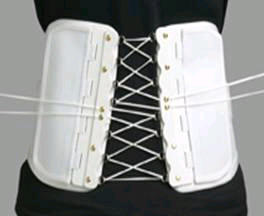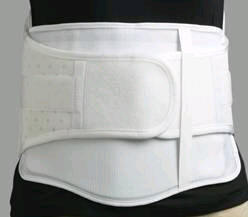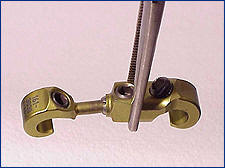|
Applications
Superstat is an active topical
hemostat in solid form that is economical and ready to use. The patented, freeze
dried combination of physiological calcium and soluble, positively charged
collagen, dissolves on contact with shed blood, producing rapid hemostasis in
the local area. Superstat's greatest asset is hemostasis, but its rapid
dissolution prevents any type of foreign body reaction.
Place Superstat over a bleeding
area, cover with a lap pad or gauze, and compress lightly. In two to three
minutes, the Superstat has interreacted with blood, dissolved and produced a
clot.
EASY TO USE
1- Sponge or aspirate
excess blood that may have pooled
2- Apply Superstat to
the bleed site
3- Cover Superstat
with dry lap pad or gauze sponge
4- After 2-3 minutes, remove
lap pad. Superstat has dissolved and hemostasis
and apply light
pressure has
occurred
Examples of
Superstat use in typical surgical applications.

Anastomosis - Bleeding or oozing from vessel
repair such as carotid, femoral or distal femoral popliteal anastomosis
responds nicely to Superstat application. Place Superstat in the area of
surgical repair. Gently pack the area with a four by eight or a small lap
pad and compress lightly. Remove after 2 or 3 minutes.
Cardiac vein bypass surgery as
well as arterial transfer such as internal mammary artery frequently leads
to small areas of bleeding on the vessel surface after aortic pressure is
reestablished. Hemostasis is obtained by applying Superstat in very small
amounts to the surgical site, packing with sponges and applying gentle
compression. Hemostasis takes approximately two and one-half to three
minutes.
Tunnels - Diffuse oozing caused by blunt
dissection, such as a tunnel for a graft, responds to Superstat by gently
inserting long strips into the tunnel from both ends. Compress the skin or
soft tissue area over the bleeding. The Superstat will dissolve and diffuse
the length of the tunnel ultimately producing hemostasis. Irrigate the
tunnel with saline after Superstat application. Repeat the procedure if
adequate hemostasis is not achieved.
Spleen - Bleeding from the capsule of the
spleen, which could be inadvertently abraded with the end of a retractor,
can be controlled by direct application of 1.5% Superstat on the bleeding
area. Tie the Superstat to a Davis and Geck Dexon Bag to assist hemostasis.
The bag may be left in place permanently. The Superstat will dissolve and
the Dexon Bag will function permanently as a support for the spleen.
Livers - Apply the entire Superstat pad,
either 1.5% or 3%, to the area of trauma or directly into the stellated area
of the liver filling every crevice and compress with three or four large lap
pads. The Superstat activates the local clotting factors enabling hemostasis
immediately.
The hemiresected liver surface
can be packed directly with a large five by five-inch square of 3% Superstat
and compressed by a couple of laps and/or a towel. Hemostasis is realized in
approximately five minutes. The large vessels at the surface (> than 2mm)
require suturing.
Plastic Surgery - Superstat produces
hemostasis in dissected flaps during face reconstruction. Flap bleeding is
controlled with Superstat, sponges and compression after termination of the
dissection and prior to re-approximating the skin edges. Superstat has often
mitigated against the capillary bleeding which requires
epinephrine-xylocaine injections. The Superstat prevents long term
hemostasis-ecchymosis. Larger dissections such as breast reconstruction also
benefits from Superstat application.
Ear, Nose and Throat - Superstat has proven
remarkedly beneficial in ear, nose and throat procedures, particularly
nosebleeds. Superstat is rolled into a conical shape and packed into the
nasal passage to produce hemostasis. It is beneficial for cheek lacerations
around the mouth, bleeding gums after surgery and maxilliofacial surgery
since there is no residual to act as a foreign body.
Orthopedic Surgery
Application includes any blind, diffuse bleeding wherein the source
of bleeding cannot be identified or vessels cannot be clamped. Diffuse
bleeding from fractures or donor graft sites respond to direct application,
sponges and compression.
Spinal Surgery: Spinal fusions
produce areas of diffuse bleeding. Superstat stops this diffuse bleeding in
the prepared graft site and produces hemostasis after bone grafting with
another application if necessary. Superstat can be applied to the donor site
as well. Application of Superstat supplement with blood over the dura after
laminection produces a clot potentially mitigating against small dural leaks
of cerebral spinal fluid after decompression and possible spinal headaches.
Surgery
Application in Emergency Departments include control of any areas
of diffuse bleeding such as the scalp or face lacerations prior to wound
closure.
| 



